22 Most Popular Viking Symbols (Norse Mythology)
In this article, you can find some of the most famous Viking symbols: Runes, Aegishjalmur (Helm of Awe), The Troll Cross, Mjölnir (Thors Hammer), Viking Ax, The Swastika, Vegvisir, Valknut, Yggdrasil (Tree of Life), Triquetra, The Horn Triskelion, Huginn and Muninn, Svefnthorn, Gungnir (Odin's Spear), The Web of Wyrd, Longship, 8-Legged Horse, Dragons, Cats, Bears, Boars, and Wolves.
Key Takeaways
- Valknut: Also known as the "knot of the slain," the Valknut is associated with Odin and represents the interconnectedness of life, death, and the afterlife.
- Mjolnir (Thor's Hammer): Thor's Hammer, Mjolnir, is a powerful symbol of protection, strength, and the thunder god Thor in Norse mythology.
- Yggdrasil: Yggdrasil is the World Tree, a sacred, giant ash tree that connects all realms in Norse cosmology, symbolizing the interconnectedness of all things.
- Aegishjalmur (Helm Of Awe): A protective symbol, the Helm of Awe is believed to provide invincibility and protection in battle.
- Vegvisir: Known as the Norse compass, Vegvisir is a runic symbol believed to guide travelers through rough weather and help them find their way.
- Valkyrie: Valkyries were warrior maidens serving Odin, selecting those who may die and those who may live in battle. The image of a Valkyrie is a symbol of courage and valor.
- Gungnir: Gungnir is the magical spear of Odin, known for its ability to always hit its target. It symbolizes Odin's power and authority.
- Huginn And Muninn: Odin's ravens, Huginn (thought) and Muninn (memory), symbolize wisdom and knowledge. They travel the world to gather information for Odin.
- Fenrir: Fenrir, the giant wolf, represents chaos and destruction. Bound by the gods, Fenrir is a symbol of the uncontrollable forces in the world.
- Aegir's Helm: A magical helm associated with the sea god Aegir, it is a symbol of protection and strength, particularly in maritime activities.
RELATED: 108 Riveting October Quotes To Inspire You To Love The Beauty
Overview of Viking Symbols

- Norse Culture: Symbols akin to religious iconography for Vikings
- Deep Spirituality: No distinct word for religion; cosmic forces and fate integral
- Marvel Influence: Thor's hammer (Mjolnir) popular in Viking jewelry
- Sacred Writing: Runes used, but writing considered magical; oral tradition prevalent
- Oral Transmission: Stories of Thor, Freya, Odin passed down through generations
- Symbolic Power: Symbols conveyed critical messages, believed to hold power
- Harsh Existence: Vikings faced seas, battle hazards, weather extremes
- Guiding Fate: Sense of fate's hand throughout challenges
- Divine Symbols: Adorned items like boundary stones, amulets, shields, longships
- Edge In Uncertainties: Symbols provided perceived advantage in facing life's dangers.
Runes (Norse Mythology Symbols - Alphabet)
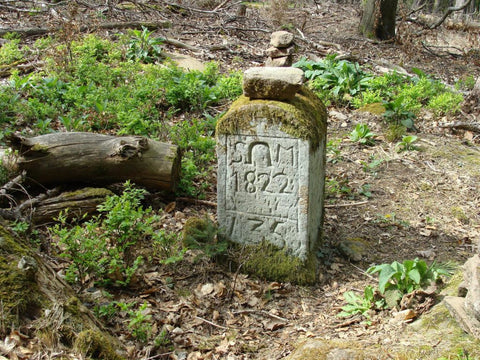
- Norse Runes: Norse Runes are letters with the word "rune" meaning "secret." They represent phonetic sounds and specific meanings, similar to other ancient languages.
- Futhark: Futhark is the Norse alphabet, with the first six runes being F, U, Th, A, R, and K. The term is similar to "alphabet," which comes from the first two Greek letters.
- Evolution And Use: The earliest known futhark evolved between the second and fourth centuries during increased warfare and trade between Germanic and Mediterranean peoples.
- Viking Writing Practices: Vikings had an oral culture and carved runes into stone, bone, wood, or metal instead of using parchment. Surviving stories about Vikings are often found on carved rune stones.
- Rune Carving For Protection: Runes were carved on talismans, shields, beads, and amulets for protection and assurance of victory during the Viking Age.
- Rune Casting: Rune casting involved spilling bits of wood or bone with runes onto a fabric, similar to casting rune sticks. Skilled practitioners deciphered the message based on the runes and their alignment.
- Odin's Connection: Runes are linked to the god Odin, who discovered them from the Well of Destiny at the foot of Ygdrassil. Vikings considered runes not only as human-made tools but also as part of a broader truth.
- Elder Futhark: The Elder Futhark, known as the first runes, was widely used across Germanic and Norse nations. It began giving way to the Younger Futhark just before the Viking Age, reflecting changes in language and dialects.
- Younger Futhark: The Younger Futhark had fewer runes (just 16) and emerged to represent changes in Scandinavian languages. The transition from Elder to Younger Futhark was gradual.
- Rune Lore Knowledge: Vikings knowledgeable in rune lore could likely read both versions. The Elder Futhark is still reflected in modern Viking jewelry, containing more letters for easy translation into English.
Aegishjalmur - Helm of Awe (Norse Mythology Symbol)
- Aegishjalmur (Helm of Awe): Prominent Viking symbol for protection and victory
- Symbol Composition: Eight radiant tridents encircle a central point, guarding it
- Etymology: "Aegishjalmur" derived from "aegis" (shield) and "hjalmr" (helm)
- Viking Warriors: Wore Aegishjalmur on foreheads for protection and instilling fear in enemies
- Modern Use: Aegishjalmur widely tattooed, serves as a protective amulet
- Alternative Name: "Helm of Awe," initially meant as a "covering" according to runologist Stephen Flowers
- Symbolic Power: Originally designed to terrify adversaries, similar to serpents immobilizing prey.
- Pineal Gland Connection: Helm of Awe seen as a force emanating from the pineal gland and eyes.
The Troll Cross (Norse Mythology Symbol)
The Norse symbol of protection is the Troll Cross, and shaped like an Othala rune. Regarded as a part of Swedish folklore.
According to Norse mythology, the Troll Cross served as a protective amulet against trolls, evil elves, and dark magic. Vikings believed that by wearing this symbol, it greatly reduces their chances of coming into trouble.
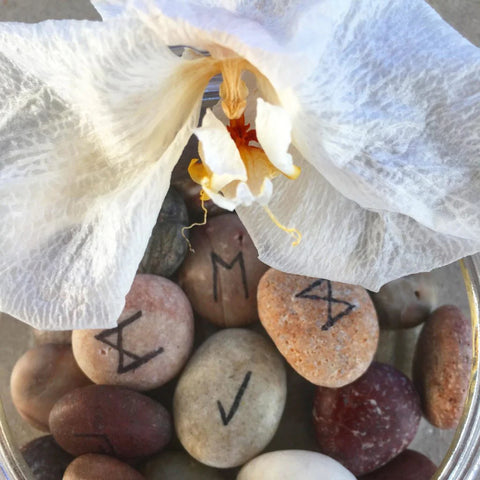
Mjölnir (Thor's Hammer)
| Attribute | Description |
| Symbol | Thor's Hammer or Mjölnir |
| Thor's Role | God of thunder and war, son of Odin and Fyorgyn, a popular figure in Norse mythology |
| Origins of Mjölnir | Described in Skaldskaparmal from Snorri’s Edda, crafted by dwarves Brokkr and Sindri |
| Mjölnir's Attributes | Legendary capacity to smash mountains, used as both a weapon and a tool by Thor |
| Blessing and Protection | Thor used Mjölnir to bless, hallow, and defend, invoked during rituals like marriages and births |
| Archaeological Significance | Hundreds of Mjölnir amulets found in Viking graves and Norse sites |
| Other Meanings | Represents power, strength, bravery, good luck, and protection; symbolizes respect for the Old Ways |
| Norse Christians | Continued wearing Mjölnir amulets after the transition from Old Ways, signifying enduring importance |
| Symbolic Significance | Represents Thor's role in saving humans and protecting the land from disorder and giants |
- Thor's Hammer Or Mjölnir: Crucial symbol in Viking/Norse mythology, representing a crusher, grinder, hammer, thunder, and lightning
- Thor's Role: God of thunder and war, son of Odin and Fyorgyn, a popular figure in Norse mythology
- Origins Of Mjölnir: Described in Skaldskaparmal from Snorri’s Edda, crafted by dwarves Brokkr and Sindri
- Mjölnir's Attributes: Legendary capacity to smash mountains, used as both a weapon and a tool by Thor
- Blessing And Protection: Thor used Mjölnir to bless, hallow, and defend, invoked during rituals like marriages and births
- Archaeological Significance: Hundreds of Mjölnir amulets found in Viking graves and Norse sites
- Other Meanings: Represents power, strength, bravery, good luck, and protection; symbolizes respect for the Old Ways
- Norse Christians: Continued wearing Mjölnir amulets after the transition from Old Ways, signifying enduring importance
- Symbolic Significance: Represents Thor's role in saving humans and protecting the land from disorder and giants.

Viking Ax (Norse Mythology Weapon)
Variety Of Axes
Ranging from hand axes to long-shafted battle axes, the Viking axe was a common and renowned weapon.Single-Bitted Design
Unlike fantasy illustrations, Viking axes were single-bitted; some were “bearded,” featuring a hook-shaped lower half for grasping and pulling.
Practicality And Accessibility
Axes required less iron, time, and expertise to make than swords, and Vikings, familiar with axes from childhood, used them extensively on farms and homesteads.
Symbol Of Norse Skill
The proficiency with the Viking axe made Norsemen sought-after as elite mercenaries or bodyguards long after the Viking Age.
God Of Thunder Worshiped By Vikings
In their travels east, Vikings encountered people worshiping Perun, another god of thunder like Thor, associated with the Balts and Slavs.
Perun’s Attributes
Similar to Thor, Perun was a sky god, guardian of mankind, and a monster slayer, riding a goat-drawn chariot across the sky.
Battle Tool Comparison
Unlike Thor’s hammer, Mjolnir, Perun wielded an axe in battles, reflected in numerous ax-shaped amulets found in the Baltic, Russia, and Ukraine.
Symbolic Significance
The axe symbolizes strength, bravery, and audacity, serving as a reminder of ancestral achievements and a berserker’s spirit.
Expressing Mental Prowess
The axe represents the ability of the heart or mind to cut through obstacles and move forward boldly, embodying the Viking spirit.

The Swastika
One of the Viking symbols that has completely lost its meaning is the Swastika. This emblem has special meaning for Vikings and Indo-Europeans, who used it to represent holiness, continuity, power, and luck.
It is akin with Thor in the Norse religion. Inscribed on items often, the Swastika bring their owners luck and holiness.
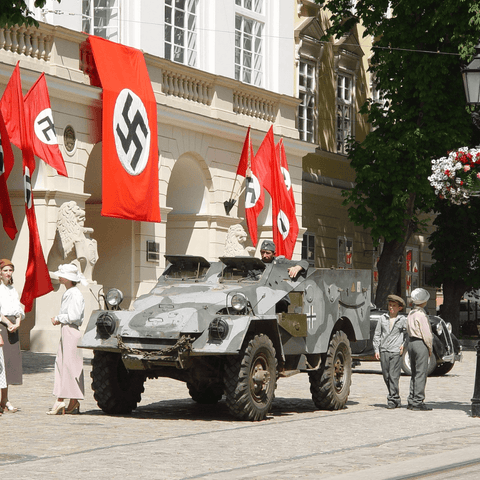
However, Hitler appropriated the Viking iconography, and connects it with the Nazi party and Hitler ever since.
Vegvisir Symbol or the Viking Compass (Icelandic Compass - Norse Mythology)
Viking Compass is often confused with Aegishjalmur because the Vegvisir symbol has eight branches, each distinct from the others. It's also a symbol in Icelandic grimoires.
It is a wayfinding symbol, that according to the grimoire, even if the user have no idea where they are heading to, is never going to be astray.
The Viking Compass is for physical navigation. The symbol becomes connected with spiritual direction in modern Asatru.
Given the fact that Vikings were prone to numerous sea tragedies, it's easy to see why they wanted mystical assistance to accompany them and keep them on track.
The Huld Manuscript contains this Vegvisir symbol. Unfortunately, there is no information on how old this symbol is.
On the other hand, Icelandic people are descendants of Vikings who have spent their entire lives sailing the open seas.
Nowadays, we have access to a wide range of contemporary technologies that can assist us in overcoming numerous marine disasters as well as preventing the loss of direction.
Even though there were no technologies available to overcome struggles at the time, the Vikings believed in symbols, and Vegvisir is one of them. It may help them find their path in life and aid them on their lengthy journeys.
Before setting sail, Vikings utilized this symbol and wrote it on their ships to ensure that they would return home safely and without injury.
However, it's also worth noting that there's not a lot of information available about the symbol's genesis. As a result, we can't be sure that Vegvisir existed throughout the Viking era.
RELATED: 124 Caring Quotes To Show Compassion To Yourself & Others
Valknut Symbol (Knot of the Slain Warrior)
| Attribute | Description |
|---|---|
| Symbol | Valknut: Odin’s Knot, a common Viking symbol, composed of three overlapping triangles |
| Valhalla Connection | Associated with Odin and the dead, believed to be a Valhalla emblem |
| Significance of Valhalla | Represents Odin's hall where valiant slain warriors reside until summoned for Ragnarok's battle |
| Symbolic Meaning | Possibly indicates passage to Valhalla, summoning Valkyries, and wards off spirits to other Norse underworlds |
| Nine Points Significance | Symbol has nine points, reflecting the importance of the number 9 in Viking culture |
| Historical Artifacts | Found on stones like Stora Hammar in Lärbro, Sweden, depicting Odin rescuing a fallen warrior; also on Tängelgarda stone from Gotland |
| Unique Discovery | Valknut on a gold ring recovered in the Nene River near Peterborough, England, in 1855, with two discs around a circle and three granule clusters on either side |
| Ritual Symbolism | Used to summon Odin’s servants, the Valkyries, or to bless fallen warriors on their journey to Valhalla |
| Continued Importance | Represents the shared goal among warriors to repel Ragnarok, the ultimate battle in Norse mythology |
- Valknut Symbol: Common in Viking culture, Odin’s Knot or the knot of the slain warrior, composed of three overlapping triangles
- Valhalla Connection: Often associated with Odin and the dead, believed to be a Valhalla emblem
- Valhalla's Significance: Odin's hall where valiant slain warriors reside until summoned for Ragnarok's ultimate battle
- Symbolic Meaning: Possibly indicating passage to Valhalla or summoning Valkyries to carry the soul; wards off spirits to other Norse underworlds
- Nine Points Significance: The Valknut symbol has nine points, reflecting the significance of the number 9 in Viking culture associated with the nine worlds of northern mythology.
- Historical Artifacts: Found on the Stora Hammar stone in Lärbro, Sweden, depicting Odin rescuing a fallen warrior; also on the Tängelgarda stone from Gotland.
- Unique Discovery: Valknut on a gold ring recovered in the Nene River near Peterborough, England, in 1855, featuring two discs opposite each other around a circle and three granule clusters on either side.
- Ritual Symbolism: Used to summon Odin’s servants, the Valkyries, or to bless fallen warriors on their journey to Valhalla.
- Continued Importance: Represents the shared goal among warriors to repel Ragnarok, the ultimate battle in Norse mythology.

Norse Symbol Yggdrasil (Tree Of Life)
Symbolism
Depicted as an evergreen ash tree, Yggdrasil is the largest and most perfect of all trees in Norse mythology.
Cosmic Connection
Its branches extend over the nine worlds, serving as a link between heaven and earth.
Symbolic Representation
Yggdrasil symbolizes the cosmic tree, the tree of life, and the world's center in Viking culture.Foundation Of Nordic Faith
Considered one of the most important symbols, Yggdrasil represents all life and underpins the Nordic faith.
Interconnected Worlds
According to Vikings, the nine worlds are stored in the tree's roots and branches, with life-giving water flowing between them.
Order In The Universe
The tree separates realms, maintaining order in the universe by connecting different worlds.
Myth And Reality
Myth serves as a way for humanity to understand cosmic reality, with Yggdrasil offering a conceptual framework similar to our contemporary scientific understanding.
Thematic Comparisons
While uniquely Norse-Germanic, the concept of Yggdrasil parallels other "trees of life" found in ancient shamanism and various religions.
Symbolic Meanings
Yggdrasil embodies themes of the cosmos, the relationship between time and destiny, harmony, creation cycles, and the essence of nature.
Interconnectedness In Mythology
Yggdrasil appears in the mythology of many ancient cultures, symbolizing the interconnectedness of the world and the eternal cycle of transformation.
Ragnarok Connection
Yggdrasil's fruits give gods youth, and it plays a role in Ragnarok, the war between gods and giants, where a man and woman survive to give the world a new beginning.
Dual Nature
Yggdrasil is seen as both a tree of life and a "tree of horror" because Odin hung himself on it in a quest for wisdom and self-sacrifice.

Triquetra (Celtic Knot)
The Trinity Knot, also known as the Triquetra, is one continuous line that wraps around itself, implying that there is no beginning or end to spiritual existence. The Triquetra and other Celtic symbols were originally Celtic, not Norse.
Still, with more interaction and assimilation between the Vikings and the peoples of Ireland and Scotland, they became culturally syncretized.
On the Funbo Runestone, a design identical to this was discovered in Uppland, Sweden. The Celtic Mother Goddess associates with the Triquetra initially, which reflected her triune nature (the mother, the maiden, and the wise, old woman).
The threefold identity was vital in many parts of druidic doctrine and practice. The Irish and Scottish monks use Triquetra later to symbolize the Christian Trinity.
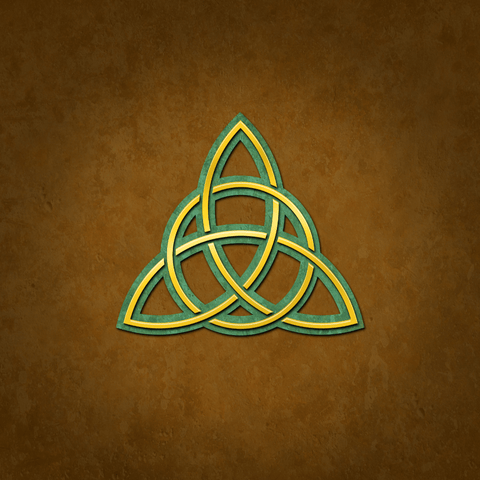
This symbol signifies the three words: celestial, physical, and spiritual. The other Trinity connections associated with this symbol are past, present, and future; sky, water, and earth; life, death, and rebirth; creation, destruction, and protection.
Because this symbol is related to the Mead of Poetry, many modern accessories feature this symbol image that is specifically made to inspire everyone who wears them.
People today wear the Triquetra for any of these reasons and to be reminded of higher truths' continuity and multi-faceted nature.
The Horn Triskelion (Viking Symbol)
Another Viking symbol that was widespread throughout the Viking era was the Triskelion. Its three interconnected horns represented three horns in Odin's search for magical mead, also known as Odhroerir or Mead of Poetry.
According to Viking legend, two dwarfs named Fjalar and Galar killed Kvasir (a man or a god). He was created from a spit of Aesir and Vanir, who possessed the inhuman ability to know everything and answer any question.
The blood of Kvasir was mixed with honey and poured into the three horns.
Odin utilized his cunning plan every day to ensure that the giant Gunnlö let him swallow a sip of mead (which lasted for three days). However, allowing him only one taste of mead every day.
As a result, each time he drank mead, he drank a whole horn, and in three days, he consumed three horns of the poetic mead, which assisted Odin in escaping by turning him into an eagle.
The Triskele symbol was first discovered in the eighth or ninth centuries. The earliest discovery is on the Larbro stone in Sweden, and it is to date from the 8th century. The Snoldelev Stone is linked to the other rune discovery from the 9th century in Denmark.
Because of its relationship to Odin's artistic attributes and the Mead of Poetry, the Horn Triskelion or Triple Horn of Odin is now utilized as a sign of inspiration and knowledge by artists and authors.
Huginn And Muninn
- Huginn and Muninn: Odin's Ravens: Huginn and Muninn are twin ravens belonging to Odin, the Norse god. They serve as messengers, depicted often seated next to Odin or on his shoulders in artworks.
- Role as Odin's Eyes: These ravens act as Odin's eyes, flying around the world daily to observe events. Upon returning to Odin, they relay the information about what they have seen.
- Special Skills and Conscious Projections: Odin granted Huginn and Muninn special skills, enabling them to travel across Midgard in one day and understand human language. Some theories suggest they are projections of Odin's consciousness, supported by the literal meanings of 'Huginn' and 'Muninn,' which translate to 'thought' and 'mind.'
- Viking Symbolism: Vikings, including notable figures like Ragnar Lothbrok, considered ravens, particularly Huginn and Muninn, crucial symbols. They believed in the ravens' ability to see everything, especially when navigating unfamiliar waters.
- Navigational Aid for Vikings: Vikings, valuing Norse animal symbolism, believed that ravens could assist them in finding land during sea voyages. Ravens were released periodically to scout the surroundings, flying back to the ship if land was not sighted.
- Floki's Discovery of Iceland: In a famous Viking story, Floki, a legendary Viking, is said to have discovered Iceland with the help of ravens, showcasing the significance of these birds in Norse exploration and navigation.
Svefnthorn (Norse Mythology)
Svefnthorn is a well-known Norse mythology symbol that appears regularly in Norse sagas such as The Saga of the Volsungs, The Saga of King Hrolf Kraki, and The Saga of the Gongu-Hrolfs.

Every myth has a distinct interpretation of this Viking symbol's meaning and magical capabilities. Svefnthorn, on the other hand, had one use in all stores: it was used to put their enemies to sleep.
For instance, according to The Saga of the Volsungs, Odin used Svefnthorn to put Valkyrie Brunhild into a deep sleep.
Gungnir
| Attribute | Description |
|---|---|
| Name | Gungnir: Odin’s magical spear, symbolizing wisdom, inspiration, and war |
| Creation | Crafted by the sons of Invaldi, dwarfs who also made Sif’s golden hair and Frey’s ship, Skidbladnir |
| Magical Properties | Gungnir is a magical spear with runes, ensuring it never misses its target |
| Odin's Sacrifice | Odin hung from Yggdrasil for nine days, stabbing Gungnir through his chest for cosmic wisdom |
| Ritual Symbolism | Vikings used spear and hanging for sacrifices, emulating Odin's quest for wisdom |
| Symbolic Use in Wars | Odin flung Gungnir in battles, Vikings started wars by tossing a spear, symbolically offering enemies to Odin for victory |
| Symbolic Meaning | Represents ecstasy, courage, wisdom, skill, inspiration, strength, focus, precision, and faithfulness |
Odin's spear, Gungnir, is a Viking symbol connected with this god of wisdom, inspiration, and war.
Gungnir was created for Odin by the sons of Invaldi, dwarfs who also made the goddess Sif's golden hair and Frey's legendary ship, Skidbladnir. It is a magical spear with a carving of black runes into the tip. Gungnir never fails to hit its target.
Odin stabbed Gungnir through the chest and hung for nine days and nights from the world tree, Yggdrasil, to discover the runes and the cosmic truths they carried.
Because of this, Vikings and previous Scandinavian/Germanic peoples used a spear simultaneously with hanging for their sacrifices to Odin.
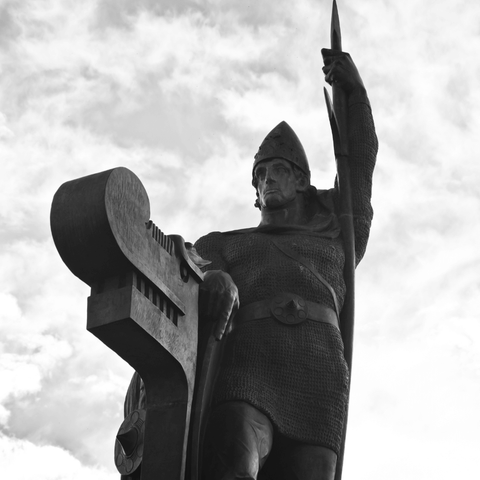
The Odin would fling Gungnir over the heads of gods, saying, "You are all mine!" while he was leading the Aesir gods against the Vanir gods.
The Vikings had a tradition of doing the same, and they would start wars by tossing a spear over the enemy's ranks while shouting, "Odin, take you all!" They felt that by symbolically offering their enemies to Odin, the Allfather would bring them victory.
Gungnir is a symbol that represents the ecstasy, courage, wisdom, skill, and inspiration of the Allfather. And it means strength, focus, precision, and faithfulness.
The Web Of Wyrd (Fate)
Viking believing that everything, even the gods, are subject to fate. The concept was so essential that the Old Scandinavian language had six different words for fate. The Vikings' famous bravery was due to their firm belief that "fate is inevitable."
Predetermining the conclusion, no man or woman even striving avoid their fate, no matter how bad it was.
What mattered most was how one dealt with the difficulties and tribulations that life threw at them. In the Viking age, this symbol represented the past, present, and future events in a person's life.
The Norns are the ones who shape fate in Norse mythology. The Norns are three ladies who sit at the bottom of Yggdrasil, the world tree, at the entrance of the Well of Urd.
They create a massive tapestry or web there, with each strand representing a human life.

According to certain traditions, notably the Volsung saga, there are numerous smaller Norns of both Aesir and elf kinds and the three great Norns (known as Past, Present, and Future).
These smaller Norn could function similarly to the guardian angels of Christianity or the demons of Greek mythology.
The Web of Wyrd symbol represents the Norns' tapestry. Although it is unknown whether this symbol was utilized during the Viking Age, it uses iconography that the Vikings would recognize right away. The emblem is made up of nine intersecting lines.
Nine is a magical number in Norse, one can find the runes within the pattern of these lines. Endowed with inherent meaning and power, are the runes from the Well of Urd.
When one looks at the nine lines of the Web of Wyrd, one sees all the runes at once. After that, revealing through symbolic form are the secrets of life and destiny.
Longship (Viking Ships) - Norse Mythology
Symbol Of The Viking Spirit: The term "Viking" refers not just to any medieval Scandinavian but to those who risked venturing into the unknown, with the longship as their vehicle.
Technological Breakthroughs: Technological advancements around the eighth century transformed Viking ships, enabling them to use oars or a square sail, making them flexible, keeled for speed and precision, and with a shallow draft crucial for mobility.
Strategic Superiority: Viking longships could navigate icy oceans, travel river routes, and outpace opponents, posing a significant challenge to Europe's strongest nations.
Dragon Ships: Also known as "dragon ships," Viking longships seemed like an extraterrestrial force unleashed upon European peoples, with monks prophesying disasters in visions of dragons during the first recorded Viking attack at Lindisfarne.
Ships In Norse Mythology: Norse mythology features two notable ships - Hel's ship, Naglfar, made from the dead's fingernails, and the gods' ship, Skíðblaðnir, designed by dwarves to fold and be carried in a pocket, symbolizing the Vikings' attitude that a good ship can transport them anywhere.
Remarkable Seafaring Achievements: Vikings sailed their ships to the Mediterranean, Iceland, Greenland, and even North America, showcasing dedication, risk-taking, rejection of limitations, and an insatiable desire to shape the world.
Deep Connection With Ships: The Vikings' bond with their ships is notable, considering these vessels were essentially glorified boats, leaving them exposed to the elements and allowing them to touch the waves and feel the seas beneath their feet.
Symbol Of Viking Identity: The dragon ship symbolizes the Vikings and encapsulates their spirit of exploration, risk-taking, and the pursuit of shaping their world.
8-Legged Horse (Sleipnir) - Norse Mythology
Odin's horse, Sleipnir, has eight legs instead of four. His additional limbs are joined by conventional limbs that grew from his shoulders and haunches. As a result, "best of the horses" is his other title.
He joined Odin on various expeditions, astounded by his power, strength, and speed. He could sprint, jump, whinny, and kick considerably quicker and louder than the other horses.
Moreover, there were no obstacles in his way. The elements could not slow Odin's horse, and if necessary, he could even fly through the air and swim across water.
Furthermore, Sleipnir has the ability to transport Odin into and out of Hell (the realm of the dead).
Horses with eight legs symbolized a means of transporting souls between the nine worlds in Norse mythology.
Sleipnir represents speed, strength, perception, endless life assurance, transcendence, and travel, among other things. Today, an extensive range of accessories with the image of Odin's famous and well-known eight-legged horse, Sleipnir, are available.
Sleipnir's symbol is particularly significant for athletes, travelers, and people who have lost their way in life or their love. It is a magnificent symbol, capable of bestowing power, spiritual protection, and enlightenment upon all who seek it.
Dragons (Norse Mythology Serpents)
Dragon Ships And Mythology: Vikings had numerous myths about dragons and giant serpents, often depicted in their art and referred to as "dragon ships" due to sleek shapes and dragon-headed prows.
Symbolic Peace Gestures: To signal peaceful arrival, Vikings occasionally removed dragon heads from their ships. Unlike medieval heraldry, Norse dragons had serpentine appearances with long, coiling bodies, and only a few had wings or the ability to breathe fire.
Cosmic Powers: Some Norse dragons, like Nhöggr and Jörmungandr, were not just massive beasts but represented cosmic forces. Nhöggr, the "Curse Striker," coiled around Yggdrasil's roots, dreaming of Ragnarok. Jörmungandr, the "World-Coiling Serpent," encircled the globe, destined to face Thor in Ragnarok.
Heroic Challenges: Viking heroes faced formidable dragons that put their courage to the test. Ragnar Lothbrok, for instance, earned his name and destiny by defeating a giant serpent.
Tale Of Fáfnir: Fáfnir, once a dwarf, transformed into a nearly indestructible monster due to greed and treachery, guarding a gold pile. His story exemplifies the intelligence and menacing nature of dragons in Norse mythology.
Rich Symbolism: Dragons in Norse mythology symbolize immense strength, great danger, and are considered apex predators. They represent both risk and opportunity, associated with vast wealth and captors of beautiful women.
Spiritual And Dark Associations: Dragons like Fáfnir may signify spiritual corruption or the darker side of human nature, challenging the creation-destruction cycle. Unlike Christian associations with the Devil, Norse dragons embody chaos, devastation, change, and rejuvenation.

Cats (Viking symbols - Norse Mythology)
| Attribute | Description |
|---|---|
| Goddess | Freya: Norse goddess of love, romance, desire, sex, war, and fertility |
| Spirit Animals | Cats are believed to be Freya's spirit animals |
| War Aspect | Freya, a terrifying goddess of war, rides into battle on her wild boar, Hildisvini ("Battle Swine") |
| Knowledge Source | Odin learns secret arts from Freya, who appreciates poetry, music, and contemplation |
| Fertility Goddess | Freya is associated with fertility, despite moments of longing for her traveling spouse |
| Desirability | Described as the object of desire for gods, giants, elves, and men in Norse mythology |
| Travel Companionship | Freya travels in a chariot driven by black or gray cats when not riding Hildisvini or using a falcon-feather cloak for shape-shifting |
| Folklorist Interpretation | Some see the cooperation of cats with Freya as a metaphor for the strength of feminine influence in Viking sagas |
| Symbolic Link | Connection between Freya's magic and her cats explains the association of cats with witches in later periods |
The Vikings believed cats are spirit animals of the Vanir goddess Freya. Freya was one of the most adored, widely worshiped, and interesting Norse goddesses or gods.
She is the goddess of love, romance, desire, and sex, but she wasn't just another version of Venus from the north.
A terrifying goddess of war she is, riding into battle on her wild boar, Hildisvini ("Battle Swine"). Odin learns much of what he knows about the secret arts from Freya. Poetry, music, and contemplation are all things she enjoys.
Freya is a goddess of fertility. Skaldic poetry reminds us that she possesses unfettered libido despite amber tears when she misses her traveling spouse.
Often describing Freya as the target of desire not only of gods but also of giants, elves, and men in Norse Mythology.
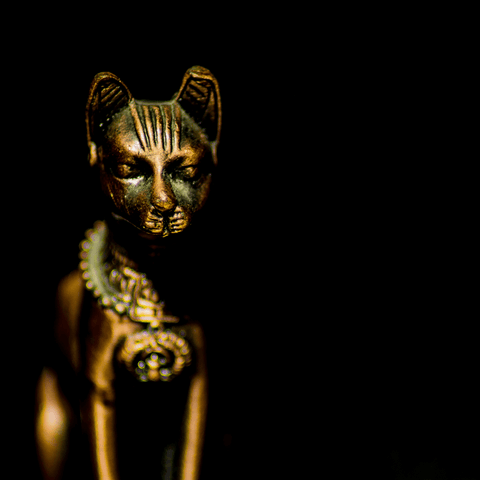
Freya traveled in a chariot driven by black or gray cats when she wasn't riding Hildisvini into battle or using her wonderful falcon-feather cloak to shape-shift into a lightning-fast bird of prey.
Some folklorists interpret the goddess's ability to get cats to cooperate and move in the same direction as a metaphor for the strength of feminine influence, which frequently appears in the Viking sagas.
Cats are autonomous but friendly when they want to be; ferocious fighters and lethal hunters but lovers of luxury, leisure, and riches.
This link between the goddess of magic and her cats explains why cats are akin with witches in the late Middle Ages and into the modern era.
Bears (Viking symbols - Norse Mythology)
The Bear was one of the Vikings' most formidable and dangerous beasts. Even the bravest of men would shrink back slowly at the sight of a bear in the wild.
Their hide and fur are resistant to most weapons, and they are enormous, quick, and deadly. So it's simple to see why it's interesting for the Vikings and wished to imitate them.
Bears were a favorite pet of Viking sea lords. Lagertha, the excellent shield-maiden, had a pet bear, which she let loose on Ragnar Lothbrok when he first came to court her, according to Saxo Grammaticus.
This incident was, understandably, brought up again during their subsequent divorce. Greenlandic Vikings excelled in bringing polar bears and polar bear furs to Medieval European courts.
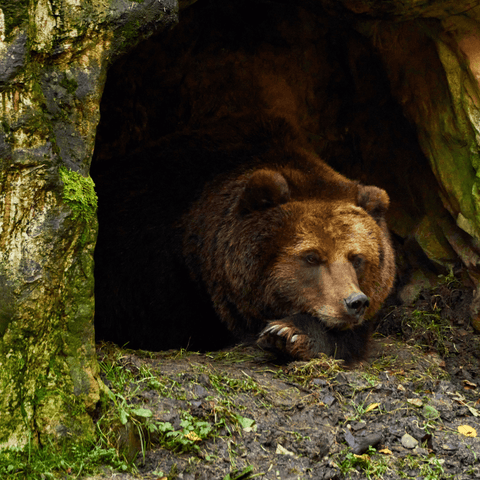
Odin held the Bear Symbol in high regard, and this connection spawned the most renowned of all Vikings: the berserkers. Berserkers were Viking warriors who fought in a delirious state of ecstasy.
What Is A Berserker?
Berserker is from two Old Norse words meaning "bear shirt" or "bear skin." It's also where the phrase "to go berserk" comes from. The berserker absorbed the essence and spirit of the Scandinavian wilderness's giant bears.
He assumed all of the Bear's ferocity, bravery, strength, and indestructibility in battle. As a result, he donned the Bear's skin, which he could have done literally by donning bear hide as armor.
Or he wears no armor at all and is completely bare (the play on words is the same in English and Old Norse). The berserker was a warrior who entered battle enraged and inspired by Odin's fatal ecstasy in either instance.
The berserker would sometimes go ahead of the line rather than fighting as a unit like the other Vikings. This craziness has a two-fold method. First, his bravery is to inspire his colleagues while disheartening his adversaries.
He hoped to break the enemy's cohesion and exploit vulnerabilities in their defenses that his brothers in arms could exploit by striking the opposing lines alone before his forces could make contact.
Boars (Norse Mythology And Celtic)
During the Viking Age, various animals symbolizes religious symbols. The exception was not wild boars. Wild boars are cautious animals who strive to stay away from humans.
When cornered, though, this animal transforms into a terrible beast. The wild boar for many years is a symbol of bravery, curiosity, and aggressiveness.

The majority of the creatures were fylgia or god's attendant spirits. Freya's fylgia boar name is Hildisvini ("Battle Swine"). Hildisvini was Freya's constant companion in battle.
Freyr or Frey (the god of male fertility, sex, riches, bounty, and peace) had a boar-fylgia named Gullinborsti. Any Viking who saw the Gullinborsti sign thought of peace and contentment.
Wolves (Fenrir) - Norse Mythology
Fenrir, The Terrifying Monster
Fenrir, the most well-known wolf in Norse mythology, was a terrifying monster with rapid growth and a ferocious appetite. The gods attempted to restrain him, but he broke every chain, leading to the loss of the deity Tyr's hand.
Fate Of Fenrir
Ultimately subdued with an unbreakable lashing, Fenrir is fated to escape during Ragnarok, the end of days. In this apocalyptic event, he will devour the sun, moon, and even kill Odin.
Duality Of Wolves
Not all wolves in Norse mythology are portrayed as evil. Wolves named Geri and Freki, accompanying Odin in war and hunting, showcase a positive alliance between humans and wolves.
Connection With Berserkers
Berserkers, Viking warriors empowered by the spirit of Odin, were known to "become the bear." Another form of Viking warrior, the lfhenar or "wolf conceals" (or werewolf), is less clear in distinction from berserkers.
Positive And Negative Associations
Wolves, sacred to Odin, had both positive and negative meanings in Norse culture. Some Vikings could channel the wolf spirit for impenetrability to "iron and fire," showcasing incredible feats of martial prowess.
Cooperation And Bravery
The alliance between humans and wolves, as seen with Geri and Freki, emphasizes positive qualities such as bravery and cooperation.
lfhenar: Berserker Variation?
The lfhenar, possibly a synonym or a distinct type of berserker, fought in small groups unlike berserkers who fought alone in front of Viking shield walls.
Symbolic Wolf In Norse Culture
Wolves in Norse culture represent both destructive forces of time and nature, as well as admired qualities of bravery, cooperation, and shamanic power. The wolf can evoke both savagery and primitive nature, bringing out the best or worst in humans.
Frequently Asked Questions
What are some key Viking symbols in Norse mythology?
Some prominent Viking symbols include the Valknut, Mjolnir (Thor's Hammer), the Helm of Awe (Aegishjalmur), the Vegvisir, and the Yggdrasil, among others. These symbols hold significant meaning in Norse culture and mythology.
What does the Valknut symbolize?
The Valknut, also known as the "knot of the slain," is associated with Odin, the Allfather. It is believed to represent the interconnectedness of life, death, and fate. Some interpret it as a symbol of sacrifice and protection.
What is the significance of Thor's Hammer (Mjolnir)?
Mjolnir is Thor's magical hammer, known for its power to protect and destroy enemies. It symbolizes strength, courage, and the protection of the Norse people. Many Norse pagans wear Mjolnir pendants as a symbol of allegiance to Thor.
What does the Helm of Awe (Aegishjalmur) symbolize?
The Helm of Awe is a protective symbol associated with strength and invincibility. Warriors often painted this symbol on their foreheads to invoke its power in battle, believing it could instill fear in their enemies and provide them with protection.
What is the Vegvisir and its significance?
The Vegvisir, also known as the Norse Compass or runic compass, is believed to be a magical stave that helps the bearer find their way in rough weather. It represents guidance, direction, and protection on life's journey.
What does the Yggdrasil symbolize in Norse mythology
Yggdrasil is the World Tree in Norse mythology, connecting all realms of existence. It symbolizes the cycle of life, death, and rebirth. The tree's branches reach into the heavens, and its roots extend into the underworld, representing the interconnectedness of all life.
Are these symbols still relevant today?
Yes, many people still find meaning in Viking symbols today. They are often used as tattoos, jewelry, and decorative elements to express a connection with Norse mythology, Viking heritage, or personal beliefs related to strength, protection, and spirituality.
Can anyone wear or use these symbols, or is there a cultural significance to consider?
While these symbols are widely recognized and appreciated, it's essential to approach them with respect for their cultural and historical significance. It's advisable to learn about the symbols' meanings and origins before using them to ensure a respectful and informed representation.
Where can I learn more about Norse mythology and Viking symbols?
There are various books, online resources, and museums dedicated to Norse mythology and Viking history. Reading works like the "Prose Edda" and the "Poetic Edda" can provide deeper insights into the mythology, while museums often showcase artifacts and information related to Viking culture.

